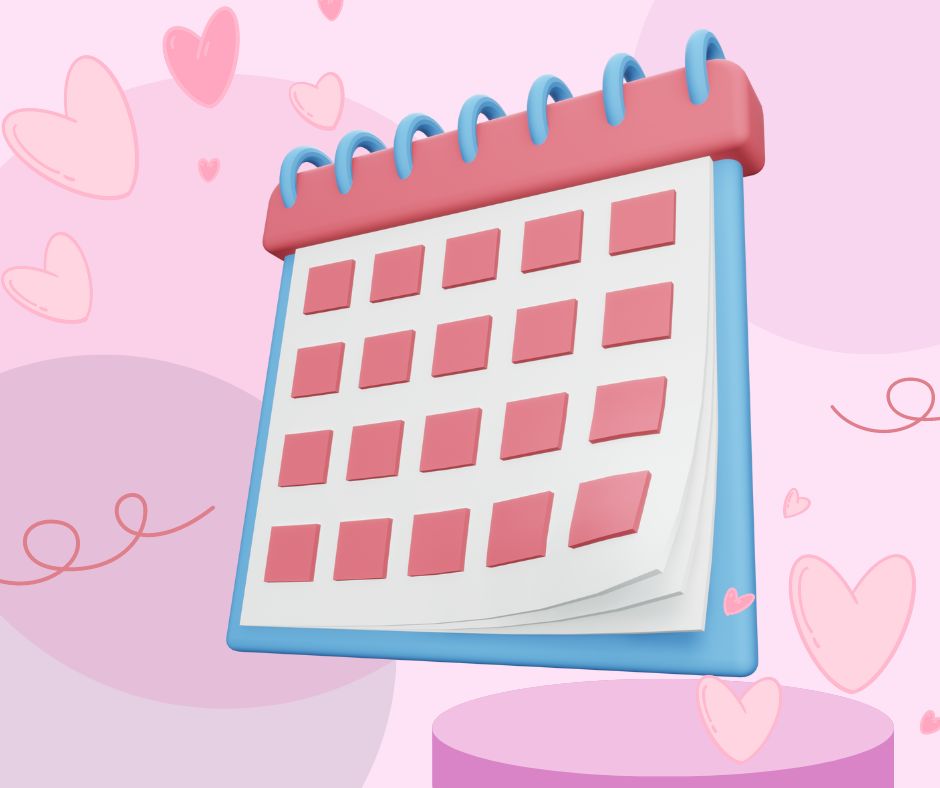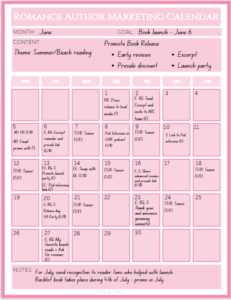A Romance Author Guide to Making a Marketing Calendar (free download)

Table of Contents
Discover how to create a marketing calendar to sell your romance novel, plus get a free downloadable calendar.
For many romance authors, marketing isn’t something they have knowledge of or experience in. As a result, their efforts are often hit and miss in terms of building book sales.
Admittedly, I’m often haphazard in my marketing and promotion. But I’m finding that having a calendar keeps me focused and consistent with my marketing.
Developing a marketing calendar can take time, but it can go a long way to helping you reach your readers and consistently engage with them to build book sales.
Understanding the Basics of a Marketing Calendar
Before we go into creating a marketing calendar, let’s dive into what they are and why they’re important to romance authors.
What is a Marketing Calendar?
A marketing calendar is a detailed plan that outlines when and how you’ll share your work with the world, from book launches to blog posts, social media blasts to signing events. But it goes beyond the big events (e.g. launches or signings) to include regular daily or weekly tasks such as social media post or email.
Why is a Marketing Calendar Important for Romance Authors?
A marketing calendar offers a plan for consistent exposure as well as focus and clarity on your messaging. If you’ve ever sat at your computer and thought, “What should I post in my reader group today?” or “What should I email my list?” then a marketing calendar can help.
Key Components of an Effective Marketing Calendar
An effective marketing calendar for a romance author should include:
- Book Launch Dates: Mark your calendar for your book’s debut and plan backwards to schedule pre-launch teasers, announcements, and promotions.
- Promotional Events: Whether virtual book tours, author signings, or panel discussions at romance literature festivals, these are milestones around which to rally your audience.
- Content Marketing: Schedule regular updates for your blog, newsletter, and social media channels. Share behind-the-scenes looks, character insights, or snippets of your writing process.
- Advertising and Promotions: Identify the best times to run ads on platforms like Facebook, Amazon, or Bookbub, and plan your budget accordingly.
- Reader Engagement: Set aside times for live chats, book club appearances, and responding to comments and emails to foster a community around your work.
Developing Your Marketing Plan
Before creating your marketing plan, you need to get a firm understanding of who you’re trying to reach. Posting to social media willy nilly is going to give you lackluster results. Marketing is all about sending the right messages to the right people. To do that, you need to answer the following questions:
- Who is your target reader? Who is the person most likely to read your book. Don’t say “romance readers” as that’s too broad. If you’ve written a historical romance, then your target reader would be one who reads historical romances. But go deeper into what it is about historical romance they enjoy. These feelings are what you want to evoke in them with your marketing. But to do that, you need to understand them and know who they are.
- What is your offer? Of course, your book, but your offer can also be your lead magnet, something about you or your brand, a special promotion or giveaway, merch, etc.
- What are the best formats for reaching your target reader? How does your reader like to consume content about books? Options include articles, videos, infographics/slides, podcasts, sales page, etc.
- Where are the best places to publish your marketing content? What platforms will you use to reach readers. Most authors have a website, email list, and social media. But what social media is best to reach YOUR reader? Facebook? Instagram? Pinterest? TikTok? Where else does your reader go to learn about the type of book you write? Book blogs? Book podcasts?
- What frequency will you post marketing content? This is where you decide what you’ll create and how often. In many cases, you may have a plan for several types of content. For example, you might create a schedule of a daily post in your reader group, TikTok post 3 times a week, a weekly email, and a monthly giveaway (e.g. through Bookfunnel).
Tools to Develop Your Marketing Plan
Your marketing calendar can take many forms, from digital platforms that sync across devices to traditional paper planners. The choice hinges on your personal workflow and needs:
- Digital Tools: Options like Google Calendar offer simplicity and accessibility, allowing you to color-code different types of
 activities and set reminders. Project management tools like Asana or Trello provide more functionality, enabling you to create tasks, assign deadlines, and track progress across campaigns. Notion offers an all-in-one location to not only organize your marketing calendar, but your content, book details, and more. For those of you using Microsoft 365, you can now use Loop or the revamped Planner/To Do.
activities and set reminders. Project management tools like Asana or Trello provide more functionality, enabling you to create tasks, assign deadlines, and track progress across campaigns. Notion offers an all-in-one location to not only organize your marketing calendar, but your content, book details, and more. For those of you using Microsoft 365, you can now use Loop or the revamped Planner/To Do. - Physical Planners: If you prefer paper (as I do), a physical planner or wall calendar can serve as a daily visual reminder of your marketing tasks. Using a disc-bound system, you can insert extra calendar pages so you can separate your marketing calendar from your other scheduled tasks and events to avoid too much clutter. Or, buy a monthly planner for a few bucks and keep it with your regular planner.
WWH Members can download the free Romance Author Marketing Planner from the Freebie Resource page. It includes tips, a sample, and blank calendar. Not a member? Join free here: Join Write with Harte
Identifying Key Dates
Once you know how you’re going to keep your marketing calendar, begin to add your marketing to dos. Start with the non-negotiables such as book launch dates or events. For promotions that have a focused time period (e.g. book launches), work backward from your launch date to include your marketing activities. For example, if your launch date is April 1, you may have Feb 1 as your cover reveal. Other dates to consider are:
- Posting Schedule: Do you email your list on a schedule? Post to your reader group on a schedule? Add these in!
- Launch dates: Add the dates you plan to publish books if you have them decided.
- Seasonal Peaks: Romance books often see a spike in sales around Valentine’s Day, during the summer beach reading season, and Christmas.
- Genre-Specific Dates: Pay attention to events like Read a Romance Month in August or significant days that resonate with themes in your books.
- Personal Milestones: Incorporate your own milestones, such as the anniversary of your first book’s publication or significant personal dates that you can share with your audience to create a connection with them.
- Themes: Content development can be easier if you have themes. For example, January can be new beginnings, February – Love, March – spring cleaning or flowers, April – taxes or rain (maybe you have a character who is a tax accountant…lol), etc.
- Time away: If you’re going on vacation or will otherwise be away, be sure to include this. You’ll either want to pre-created and schedule content, let your readers know you’re gone, or make a note to share pictures of your trip.
Setting Objectives
Don’t just willy nilly post your book cover or a quote. Have a goal, an objective on WHY your posting your book cover or a quote. What do you hope to achieve with each marketing effort? Setting clear, measurable objectives for your activities can guide your planning and help you evaluate success. Objectives might include:
- Awareness/Traffic Objectives: These are goals on reaching new readers who don’t yet know about you and enticing them to follow you on social media or sign up for your newsletter. Or, if you run ads, for them to buy. Your target objectives are generally set in numbers such as growing your reader group by x amount or adding x-number of subscribers to your email list.
- Engagement Objectives: Set targets for current followers/subscribers to interact with you. How many like or better yet, comment on a post? Or even better, share it? How many openings or clicks does your email garner? Your targets should be about increasing engagement with the readers who follow you.
- Launch Objectives: Define your goals for book launches, such as reaching a certain number of pre-orders or hitting a bestseller list.
- Sales Objectives: Aim for specific sales targets post-launch or during promotional periods to gauge the effectiveness of your marketing strategies.
Note, I like to put my objective with the content on my calendar. So if I’m doing a social post about my lead magnet, I have an A for awareness next to it.
Gathering Assets
I like to start with what I already have. Get a piece of paper or in your digital note pad, jot down notes and ideas that will eventually be added to your calendar. As you add themes and events to your calendar, jot down any marketing ideas that you think of for later inclusion on the calendar. Here’s what I like to list:
- Regular topical content. In the blogging world, this is called “pillars”. Many social media influencers call this “buckets”. It’s basically topics that you can regularly create marketing content around. These topics should relate to your books or you. For example, if husky dogs feature in your books or you own a husky, then maybe one of your regular content posts would be about huskies. If cocktails are prominent in your books, perhaps you’ll have a cocktail of the week.
- Sift through what you already have. Have you posted articles on your blog or other people’s blogs? Are there reviews or interviews on other blogs/podcasts? What graphics have you already made that could be reshared?
- Check your data to see what content has had the most engagement. Did your question about huskies get a ton of comments? Did your cocktail of the week get shared a lot? Data helps you know what works, as well as what doesn’t.
- Add other ideas that come to you as you add the calendar themes and topics.
Planning Your Marketing Activities
With your tools selected, key dates identified, objectives set, and current ideas listed, it’s time to populate your calendar. There are a bazillion different activities you can do to market. First, start with your top platforms for marketing content delivery. Here are your options:
- Blog
- Video
- Podcast
- Livestream
- Social Media
- Media (General PR)
Then there is types of content:
- Text
- Graphics
- Audio
- Video
- Slides
- Polls
- Q&A
Finally, there are two types of marketing you need to do: launch and backlist.
Launch Marketing Activities
- Pre-Launch: Schedule cover reveals, teasers, and pre-order announcements. Plan content that builds anticipation, such as character introductions or setting sneak peeks. This should start four months before launch.
- Launch Phase: Coordinate your launch day blitz with email blasts, social media posts, and perhaps a virtual launch party. Consider collaborating with book bloggers or other authors for cross-promotion.
- Post-Launch: Keep the momentum going with reader engagement activities, book club visits, and leveraging reader reviews. Plan follow-up promotions or price drops to reignite interest.
Backlist or Author Awareness Activities
- Email list building: Email is one of the most important marketing assets you can have. Building your email list can include social media posts promoting your lead magnet, email swaps, and/or giveaways through Bookfunnel.
- Social media following building: Like email, your goal here is to attract readers to follow you so they can hear about your backlist and new releases. Each platform is a bit different, and you’ll make yourself crazy trying to be on all of them. Remember, you just need to be where your reader hangs out to learn about books. You can build social media by asking your email participants to follow you, sharing your social infomation when you’re at events or a guest on a podcast, from your website, etc.
- Author life: These types of marketing posts can be sent in email or posted on social media and includes behind the scenes type content, current WIP teasers, interesting research for your WIP, what your reading, etc.
- Event announcements: If you’re going to appear at a signing or speak at an event, or be a guest on a podcast, share the news before and after, especially if there is a recording of the event.
- Reader Polls and Surveys: Gain insights into your readers’ preferences and involve them in decision-making processes (e.g., choosing a character’s name or the setting for your next book).
- Fan Features: Highlight reader reviews, artwork, or stories on your social media and newsletters, fostering a sense of community and appreciation.
- Q&A Sessions: Host regular Q&A sessions on social media or through live webinars, answering reader questions and sharing your author journey.
- Bonus content: Consider rewarding fans with extra epilogues or bonus content related to your existing books. This can keep them hooked into your book world and turn them into superfans who not only buy your books, but will tell others.
REPURPOSE!
If you’re overwhelmed by the idea of creating content for website, email, and several social media platforms, take a breath. While it is time consuming, you can use one piece of content across more than one platform. When possible, do that! Here are a few ideas:
- Video: Cut long-form video to smaller vids for Reels, TikTok, and/or YouTube
- Graphics: If you use Canva (pro) you can easily resize graphics for Instagram or Reels/TikTok
- Blog Post: Use snippets for social media teasers or quotes
- Polls: Share poll results on social, blog, and email.
- Text to Video: Use AI to convert text posts to video with Pictory or Lumen
- Audio/Video to Test: There are many AI tools that can transcribe audio and video. Use Word or other transcription option to convert audio into a transcript.
Putting Your Marketing Calendar Together
Okay, so you’ve:
- Identified your target reader
- Decided on how you’ll organize your calendar
- Added in key dates
- Gathered your assets
- Decided on platforms and content types
- Listed other ideas
Now you’re ready to fill in your calendar!
- Fill in what you already have or know about your schedule. For example, if you have a launch coming up, put that in as well as the dates for cover reveal, teasers, etc. Be sure to check the month ahead to see what’s going on as often you can create content in anticipation of upcoming events. For example, January is a good time to plan for Valentine’s Day.
- Be specific about what you’re going to create. For example, what teaser quote you’ll share or poll you’ll post. Does it include a graphic or video, or is it just text? If you’re not sure what you specifically plan to post, put a placeholder to remind you that a post or content is expected. For example, you might have placeholders of E for email list or RG for reader group post.
- Get the link, if applicable. If the marketing content will be posted by someone else (e.g. a podcast or a guest post), indicate that inb your marketing calendar and then be sure to get the link so you can let your followers/subscribers know, and promote it.
- Include your objective for the content. Have a purpose for the content and a way to measure if it was successful. You can boost the success of your objective by adding a call-to-action to your marketing content. This can be telling people to sign up for your email list, take the poll, listen to the podcast interview, or add the book to their library (as opposed to “buy now”).
 Looking for a bigger more robust marketing planner? Check out The Romance Author’s Novel Organizer that helps you plan your book from idea to sales, including:
Looking for a bigger more robust marketing planner? Check out The Romance Author’s Novel Organizer that helps you plan your book from idea to sales, including:
- tips on building your author platform
- marketing content cheat sheet
- marketing ideas
- book launch check list
- 12 non-dated calendar paced to input your goals, social media, promotions, and more.
You can get a printed Romance Author’s Novel Organizer at Amazon or a digital version you can print from the WWH shop.
Monitoring and Adjusting Your Marketing Calendar
A marketing calendar is not set in stone; it’s a living document. Regularly review your calendar to adjust for unexpected opportunities or shifts in your strategy. You’ll want to make adjustments depending on:
- Ability to maintain the schedule. You may find that you can’t post TikTok or Instagram everyday.
- New events or promotional opportunities. Something may pop up that you’ll want to add or replace a previous activity.
- Data. If something isn’t working, you’ll want to tweak it or stop it all together.









Responses